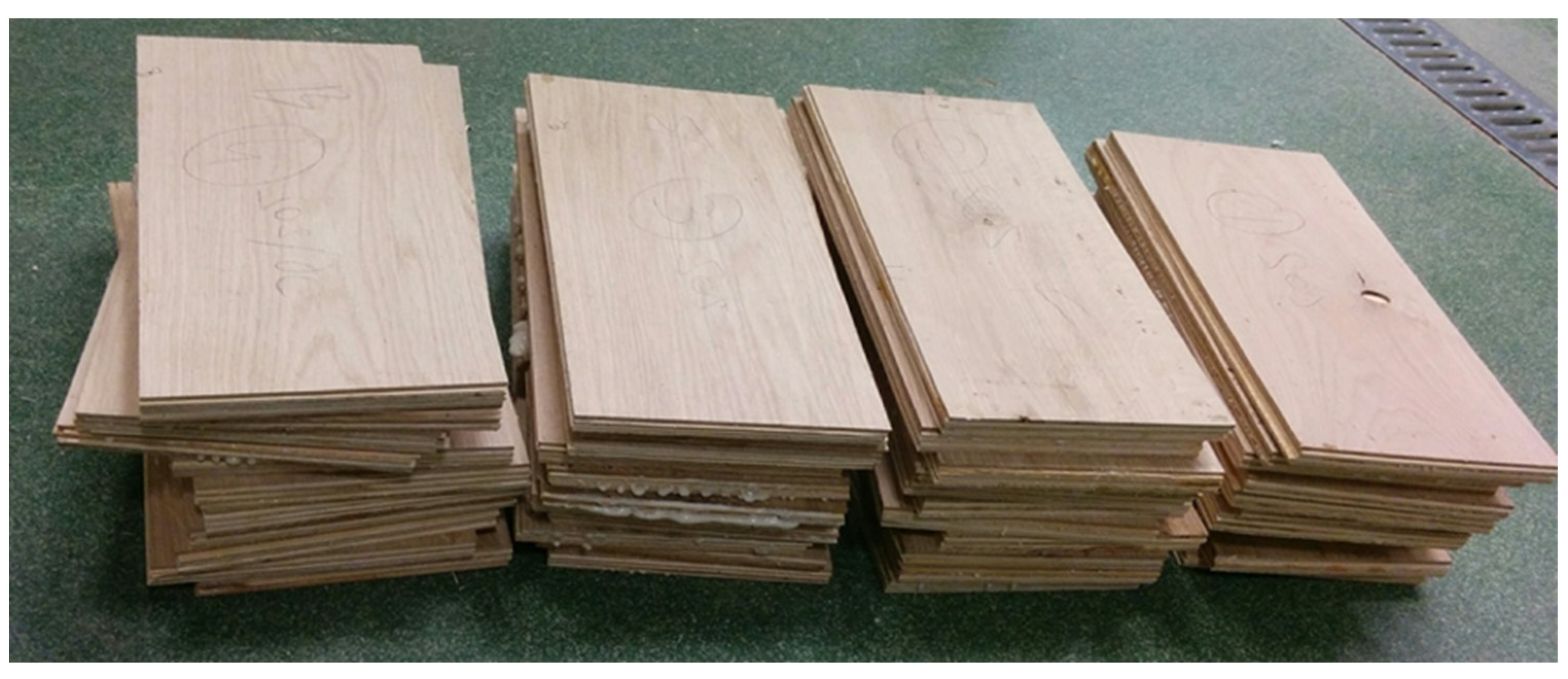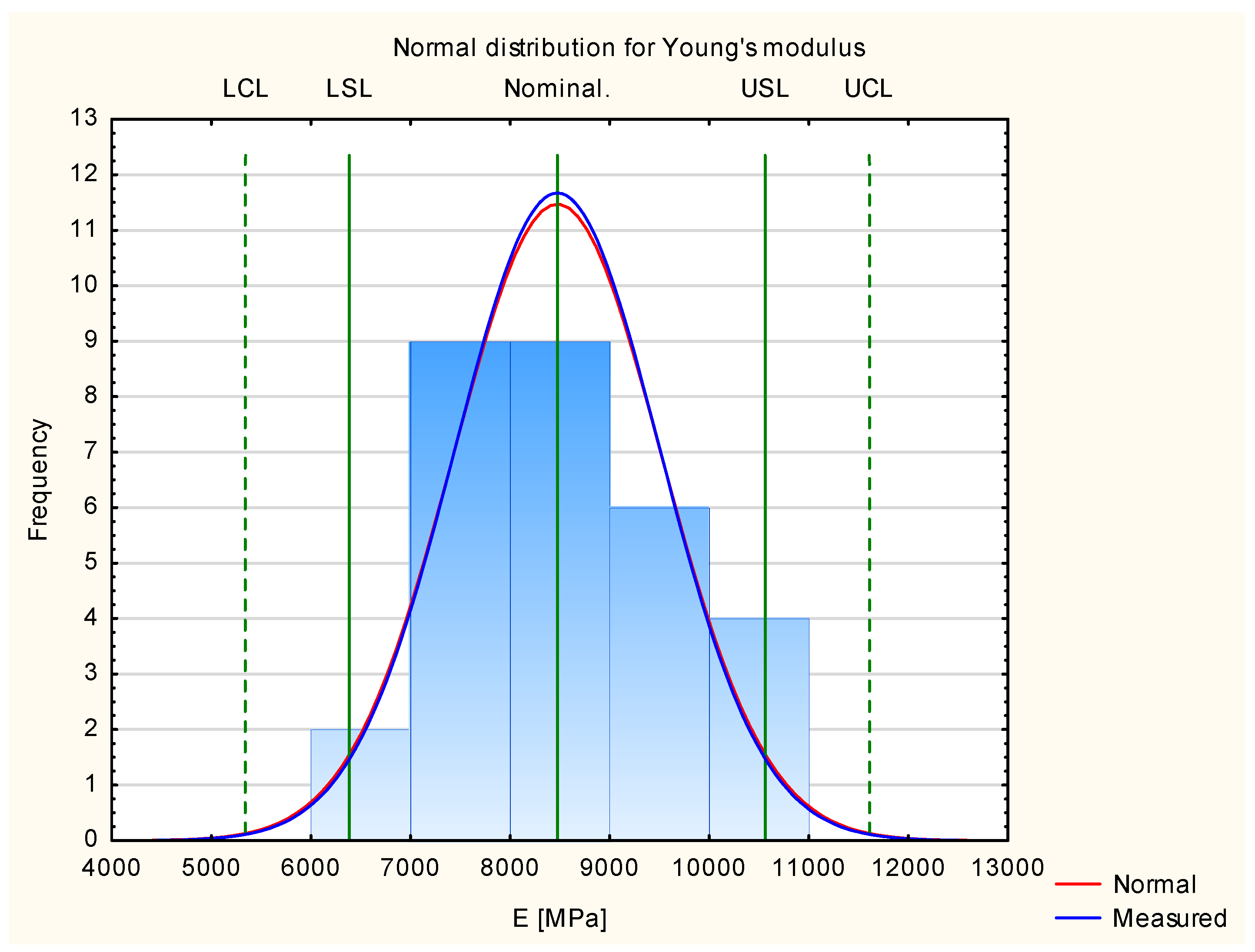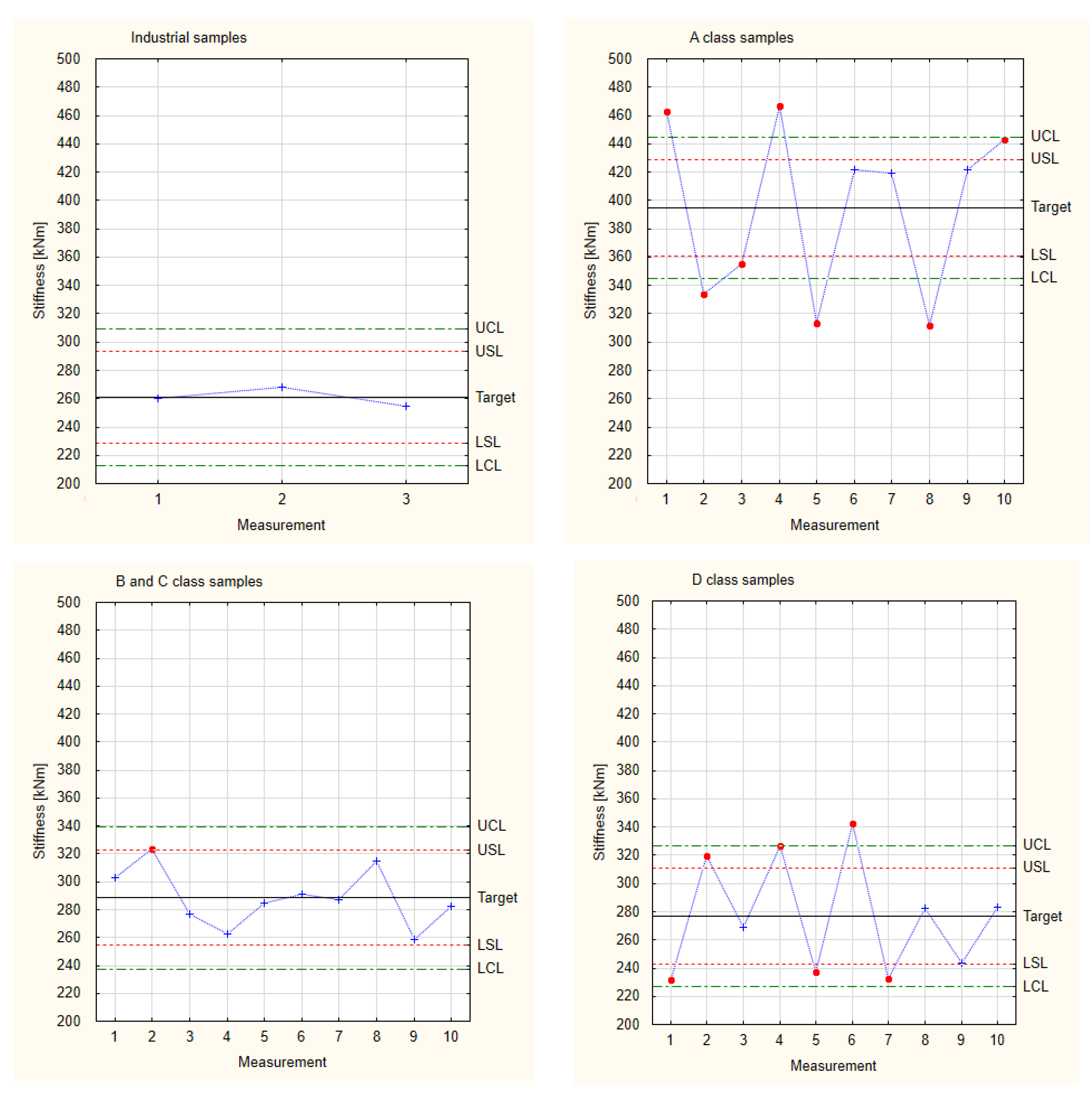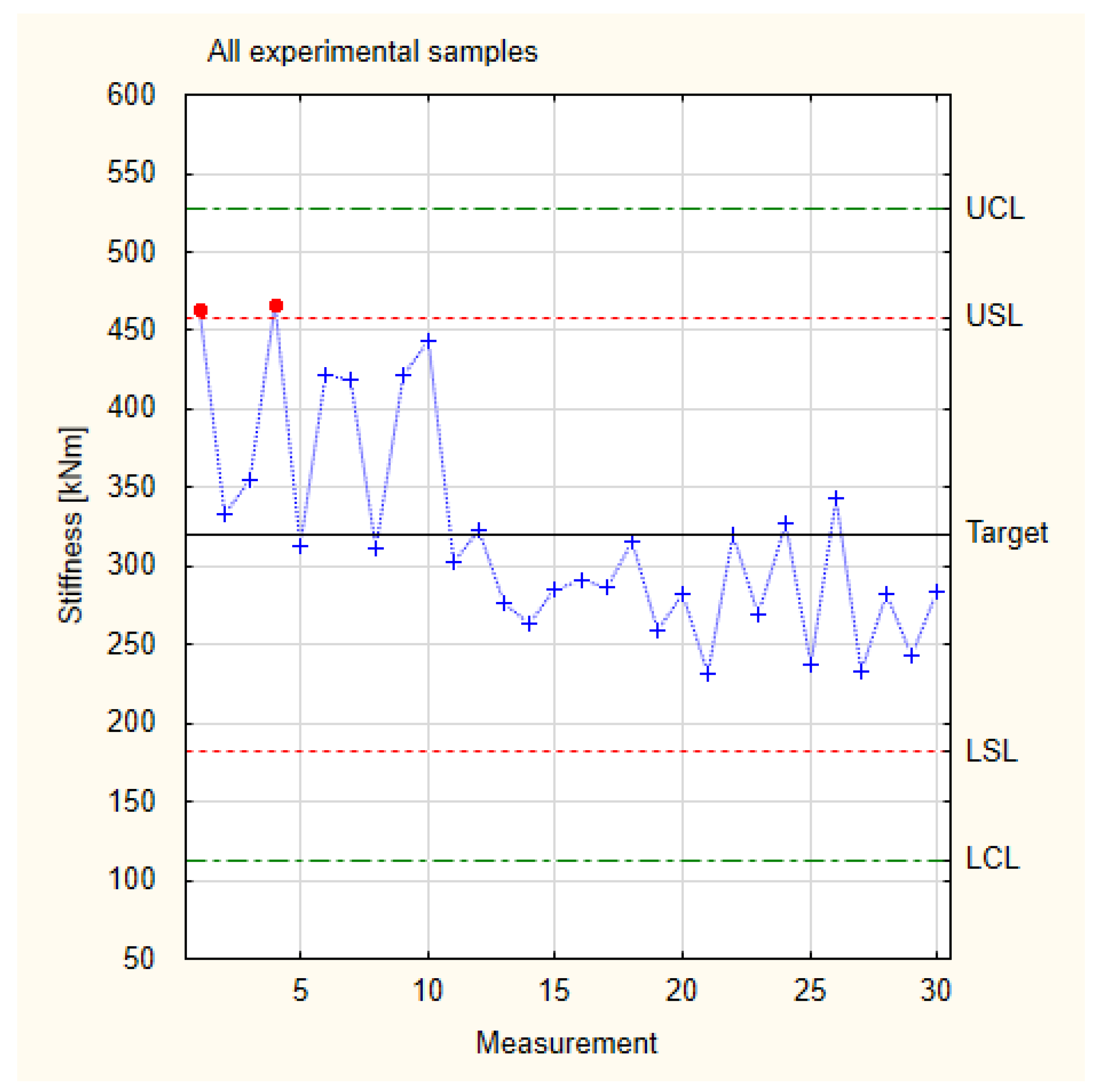Quality Evaluation of New Types of Layered Composites for Flooring Materials
Abstract
:1. Introduction
“Stresses the importance of transforming, upgrading and retrofitting the existing building stock, including poorly planned and constructed buildings erected by totalitarian regimes, of applying nature-based solutions such as wood and of reducing waste and increasing durability, re-usability and circularity in the built environment; insists that this should include favouring renovation and adaptive re-use over demolition and new builds, as appropriate, removing barriers related to the handling and transport of waste as well as raising people’s awareness about embodied and stored carbon in materials to enable them to make informed choices”.
2. Materials and Methods
2.1. Materials
2.2. Tests of Static Bending
2.3. Shewhart’s Theory Focused on the Subject of the Work
3. Results and Discussion
3.1. Young’s Modulus
3.2. Stiffness
4. Conclusions
Author Contributions
Funding
Institutional Review Board Statement
Informed Consent Statement
Data Availability Statement
Conflicts of Interest
References
- Kafel, K.; Buda, P. Geneza posadzki pałacowej—Zabytkowej warstwy wykończeniowej. Acta Sci. Pol. Archit. 2019, 18, 43–50. [Google Scholar] [CrossRef]
- Beer, P.; Pacek, P.; Burawska-Kupniewska, I.; Oleńska, S.; Różańska, A. Influence of alder (Alnus glutinosa Gaerthn.) veneers on selected mechanical properties of layered pine (Pinus sylvestris L.) composites. Ann. Wars. Univ. Life Sci. SGGW For. Wood Technol. 2019, 108, 13–20. [Google Scholar] [CrossRef]
- Blanchet, P.; Beauregard, R.; Cloutier, A.; Gendron, G.; Lefebvre, M. Evaluation of Various Engineered Wood Flooring Constructions. For. Prod. J. 2003, 53, 30–37. [Google Scholar]
- Gungor, N.M.; Kurtoglu, A.; Korkut, S. Solid Wood Flooring and Multilayered Parquet Industries in Turkey. Sci. Res. Essays 2009, 4, 1243–1247. [Google Scholar]
- Aksamija, A. Comparative Analysis of Flooring Materials: Environmental and Economic Performance. Perkins Will Res. J. 2010, 2, 55–66. [Google Scholar]
- Barlinek, S.A. Barlinek Engineered Wood Flooring. Available online: https://www.barlinek.co.uk/products/engineered-wood-flooring/ (accessed on 7 January 2022).
- Kaczkan Premium Wooden Floors. Available online: https://kaczkan.com/en/our-floors/wood-finishing/ (accessed on 7 January 2022).
- Global Wood. Available online: http://www.globalwood.be/aanbod/assortiment/ (accessed on 7 January 2022).
- Mahut, J.; Reh, R. Plywood and Decorative Veneers; Technical University in Zvolen: Zvolen, Slovakia, 2003. [Google Scholar]
- European Commission. Sustainable Industry, the European Green Deal. December 2019. Available online: https://commission.europa.eu/strategy-and-policy/priorities-2019-2024/european-green-deal_en (accessed on 14 April 2024).
- EU Green Deal. Circular Economy Action Plan, for a Cleaner and More Competitive Europe. 2019. Available online: https://environment.ec.europa.eu/strategy/circular-economy-action-plan_en (accessed on 14 April 2024).
- The New European Bauhaus, European Parliament resolution of 14 September 2022 on the new European Bauhaus (2021/2255(INI)), P9_TA(2022)0319, European Parliament, 2019–2024.
- Borysiuk, P.; Burawska-Kupniewska, I.; Auriga, R.; Kowaluk, G.; Kozakiewicz, P.; Zbieć, M. Influence of layered structure of composite timber floorboards on their hardness. Drv. Ind. 2019, 70, 399–406. [Google Scholar] [CrossRef]
- PN-92/D-95017; Surowiec Drzewny. Drewno Wielkowymiarowe Iglaste. Wspólne Wymagania i Badania. Polski Komitet Normalizacyjny: Warszawa, Poland, 1970.
- PN-92/D-95008; Surowiec Drzewny. Drewno Wielkowymiarowe Liściaste. Wspólne Wymagania i Badania. Polski Komitet Normalizacyjny: Warszawa, Poland, 1992.
- Malinowski, Z.; Wieruszeski, M. Changes in the standardisation of large-size Scots pine timber in the State Forests National Forest Holding after world war II. Sylwan 2017, 161, 287–294. [Google Scholar]
- Burawska-Kupniewska, I.; Krzosek, S.; Mańkowski, P.; Grześkiewicz, M.; Mazurek, A. The influence of pine logs (Pinus sylvestris L.) quality class on the mechanical properties of timber. Bioresources 2019, 14, 9287–9297. [Google Scholar] [CrossRef]
- Song-Yung, W.; Hon-Lin, W. Effects of Moisture Content and Specific Gravity on Static Bending Properties and Hardness of Six Wood Species. J. Wood Sci. 1999, 45, 127–133. [Google Scholar]
- Blanchet, P. Long-Term Performance of Engineered Wood Flooring When Exposed to Temperature and Humidity Cycling. For. Prod. J. 2008, 58, 37–44. [Google Scholar]
- Heräjärvi, H. Variation of Basic Density and Brinell Hardness within Mature Finnish Betula Pendula and B. Pubescens Stems. Wood Fiber Sci. 2004, 36, 216–227. [Google Scholar]
- Holmberg, H. Influence of Grain Angle on Brinell Hardness of Scots Pine (Pinus sylvestris L.). Holz Roh Werkst. 2000, 58, 91–95. [Google Scholar] [CrossRef]
- Grześkiewicz, M.; Krawiecki, J. Thermally Modified Ash and Oak Wood as Materials for Parquets—Mechanical Properties of the Wood and Its UV Resistance for Different Kinds of Wood Finishing. Ann. WULS SGGW For. Wood Technol. 2008, 65, 93–97. [Google Scholar]
- Esteves, B.M.; Pereira, H.M. Wood Modification by Heat Treatment: A Review. BioResources 2009, 4, 370–404. [Google Scholar] [CrossRef]
- Herrera-Builes, J.F.; Sepúlveda-Villarroel, V.; Osorio, J.A.; Salvo-Sepúlveda, L.; Ananías, R.A. Effect of Thermal Modification Treatment on Some Physical and Mechanical Properties of Pinus Oocarpa. Wood. For. 2021, 12, 249. [Google Scholar] [CrossRef]
- Yu, X.; Xu, D.; Sun, Y.; Geng, Y.; Fan, J.; Dai, X.; He, Z.; Dong, X.; Dong, Y.; Li, Y. Preparation of Wood-Based Panel Composites with Poplar Veneer as the Surface Layer Modified by In-Situ Polymerization of Active Monomers. Forests 2020, 11, 893. [Google Scholar] [CrossRef]
- Phillips, G.E.; Bodig, J.; Goodman, J.R. Flow grain analogy. Wood Sci. 1981, 14, 55–64. [Google Scholar]
- Vasiliki, K.; Efstratios, A.; Ioannis, B. Impact of Structural Defects on the Surface Quality of Hardwood Species Sliced Veneers. Appl. Sci. 2020, 10, 6265. [Google Scholar] [CrossRef]
- Aydin, I.; Colakoglu, G.; Hiziroglu, S. Surface characteristics of spruce veneers and shear strength of plywood as a function of log temperature in peeling process. Int. J. Solids Struct. 2006, 43, 6140–6147. [Google Scholar] [CrossRef]
- Bekhta, P.; Hiziroglu, S.; Shepelyuk, O. Properties of plywood manufactured from compressed veneer as building material. Mater. Des. 2009, 30, 947–953. [Google Scholar] [CrossRef]
- Burawska-Kupniewska, I.; Mycka, P.; Beer, P. Influence of Scots Pine (Pinus sylvestris L.) Veneers Quality on Selected Properties of Layered Composite for Flooring Materials. Forests 2021, 12, 1017. [Google Scholar] [CrossRef]
- Pande, P.; Neuman, R.P.; Cavanagh, R.R. Six Sigma: Sposób Poprawy Wyników nie Tylko Dla Firm Takich Jak GE czy Motorola; Wydawnictwo KE Liber: Warsaw, Poland, 2003. [Google Scholar]
- EN 1927-2:2008; Qualitative Classification of Softwood Round Timber—Part 2: Pines. iTeh Standards: Toronto, ON, Canada, 2008.
- EN 310: 1993; Wood-Based Panels—Determination of Modulus of Elasticity in Bending and of Bending Strength. iTeh Standards: Toronto, ON, Canada, 1993.
- ISO 9052-1; Determination of Dynamic Stiffness. Part 1: Materials Used under Floating Floors in Dwellings. ISO: Geneva, Switzerland, 1989.
- Bartkowiak, M. Karty kontrolne obrazem zmienności procesu. Kwart. Nauk. Przedsiębiorstwie 2011, 3, 63–71. [Google Scholar]
- Magaji, A.A.; Yahaya, A.; Asiribo, O.E. Assessing the effects of autocorrelation on the performance of statistical process control charts. Int. J. Math. Stat. Invent. 2015, 3, 15–23. [Google Scholar]
- Montgomery, D.C. Introduction to Statistical Quality Control, 7th ed.; John Wiley & Sons: Hoboken, NJ, USA, 2013. [Google Scholar]
- Klein, M. Two Alternatives to the Shewhart X Control Chart. J. Qual. Technol. 2000, 32, 427–431. [Google Scholar] [CrossRef]
- Faraz, A.; Saniga, E.; Montgomery, D. Percentile-based control chart design with an application to Shewhart X and S2 control charts. Qual. Reliab. Eng. Int. 2019, 35, 116–126. [Google Scholar] [CrossRef]
- Brady, J.E.; Allen, T.T. Six Sigma literature: A review and agenda for future research. Qual. Reliab. Eng. Int. 2006, 22, 335–367. [Google Scholar] [CrossRef]
- Behbahani, M.; Saghaee, A.; Noorossana, R. A case- based reasoning system development for statistical process control: Case representation and retrieval. Comput. Ind. Eng. 2012, 63, 1107–1117. [Google Scholar] [CrossRef]
- Informacja Techniczna: Konstrukcyjne Drewno Lite KVh Überwachungsgemeinschaft KVHKonstruktionsvollholz e.V. Available online: http://ekobau.pl/files/KVH-karta-techniczna-.pdf (accessed on 28 March 2024).
- Srebrzyński, K. Kontrola Jakości w Przemyśle Meblowym. Available online: https://www.woodica.pl/woodica-blog/kontrola-jakosci-w-przemysle-meblowym.html (accessed on 28 March 2024).









| Sample Group | Young’s Modulus [MPa] | Stiffness [kNm] |
|---|---|---|
| A class | 10,300 | 463 |
| 9364 | 334 | |
| 9778 | 355 | |
| 10,048 | 467 | |
| 7278 | 313 | |
| 10,115 | 422 | |
| 8337 | 419 | |
| 6597 | 312 | |
| 10,058 | 422 | |
| 9087 | 443 | |
| B/C class | 8816 | 303 |
| 8224 | 323 | |
| 8275 | 277 | |
| 7482 | 263 | |
| 7950 | 285 | |
| 7955 | 291 | |
| 7977 | 287 | |
| 8532 | 315 | |
| 8185 | 259 | |
| 9559 | 282 | |
| D class | 7597 | 232 |
| 9081 | 320 | |
| 7567 | 269 | |
| 8519 | 327 | |
| 8089 | 237 | |
| 9697 | 343 | |
| 6468 | 232 | |
| 7834 | 282 | |
| 7324 | 243 | |
| 8169 | 283 | |
| Standard deviation | 1043 | 69 |
| Lower Control Line | 5345 | 113 |
| Lower Specification Line | 6388 | 182 |
| Nominal (average value) | 8475 | 320 |
| Upper Specification Line | 10,562 | 458 |
| Upper Control Line | 11,605 | 527 |
| Sample Group | Standard Deviation for All Samples | LCL | LSL | Nominal | USL | UCL |
|---|---|---|---|---|---|---|
| Industrial | 98 | 6357 | 6455 | 6651 | 6847 | 6945 |
| A class | 8802 | 8900 | 9096 | 9292 | 9390 | |
| B/C class | 8002 | 8100 | 8296 | 8492 | 8590 | |
| D class | 7741 | 7839 | 8035 | 8231 | 8329 |
| Sample Group | Standard Deviation | LCL | LSL | Nominal | USL | UCL |
|---|---|---|---|---|---|---|
| Industrial | 17 | 209 | 226 | 260 | 294 | 311 |
| A class | 344 | 361 | 395 | 429 | 445 | |
| B and C class | 238 | 255 | 289 | 323 | 340 | |
| D class | 227 | 244 | 278 | 311 | 328 |
Disclaimer/Publisher’s Note: The statements, opinions and data contained in all publications are solely those of the individual author(s) and contributor(s) and not of MDPI and/or the editor(s). MDPI and/or the editor(s) disclaim responsibility for any injury to people or property resulting from any ideas, methods, instructions or products referred to in the content. |
© 2024 by the authors. Licensee MDPI, Basel, Switzerland. This article is an open access article distributed under the terms and conditions of the Creative Commons Attribution (CC BY) license (https://creativecommons.org/licenses/by/4.0/).
Share and Cite
Olenska, S.; Beer, P. Quality Evaluation of New Types of Layered Composites for Flooring Materials. Materials 2024, 17, 1892. https://doi.org/10.3390/ma17081892
Olenska S, Beer P. Quality Evaluation of New Types of Layered Composites for Flooring Materials. Materials. 2024; 17(8):1892. https://doi.org/10.3390/ma17081892
Chicago/Turabian StyleOlenska, Sylwia, and Piotr Beer. 2024. "Quality Evaluation of New Types of Layered Composites for Flooring Materials" Materials 17, no. 8: 1892. https://doi.org/10.3390/ma17081892





